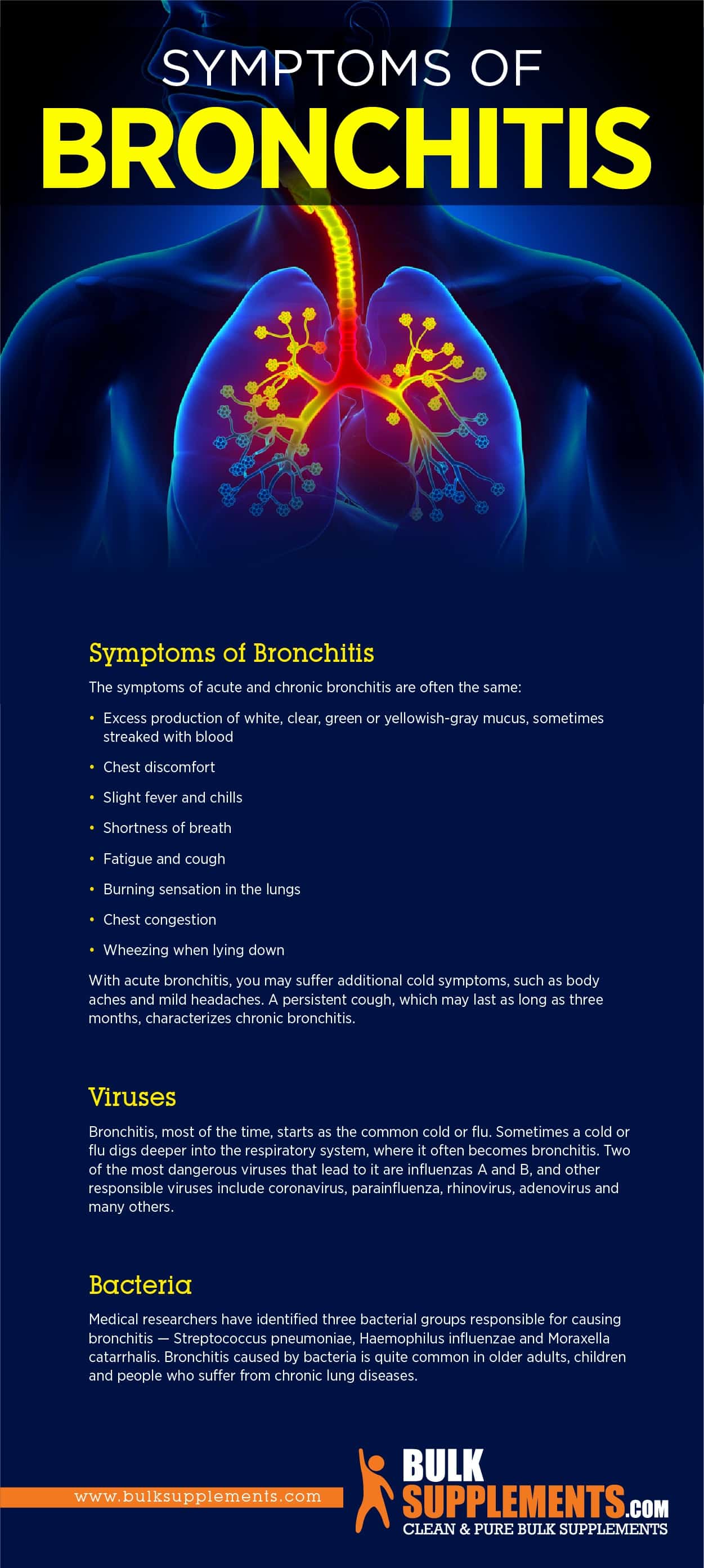Bronchitis: Symptoms, Causes & Treatment

Bronchitis
What is Bronchitis?
Bronchitis is a chest infection that occurs as a result of inflammation in the lining of the bronchial tubes, which are responsible for transporting air to and from the lungs. A hallmark symptom is thickened, discolored mucus. Bronchitis can either be chronic or acute and usually develops from respiratory infections or the common cold. Acute bronchitis is common and infectious while chronic bronchitis is more serious, longer lasting and noninfectious.
What Is Lung Capacity?
Lung capacity refers to the total amount of air someone’s lungs can hold after they take their deepest possible breath. Patients with pulmonary diseases are usually unable to exhale fully, which results in hyperinflation of the lungs. These patients tend to have higher total lung capacities.
Pneumonia and Bronchitis
Pneumonia is a lung infection, and its symptoms can sometimes overlap with those of bronchitis. A variety of pathogens — such as fungi, bacteria and viruses — cause it. People suffering from pneumonia have inflamed air sacs that can be filled with fluid or pus in their lungs. This leads to breathing difficulties and sometimes death, though uncommon, if left untreated.
What’s the Difference Between Bronchitis and Pneumonia?
While bronchitis is an inflammation of the airways, pneumonia is simply an infection of the lungs.
Can Bronchitis Turn into Pneumonia?
It can turn into pneumonia if left untreated. Infections can travel from the airways to the lungs, causing pneumonia.
How Do You Know When Bronchitis Turns into Pneumonia?
If your illness turns into pneumonia, you may experience fever, sharp chest pain, shortness of breath and confusion (more common in older adults).
What Is Chronic Pneumonia?
Chronic pneumonia, which has a prolonged presence in the body (a person can have it for weeks, sometimes months), can be either infectious or noninfectious.
How Contagious is Acute Bronchitis?
Acute bronchitis is a short-term infection best left alone to run its course. You may have it for two to three weeks, during which time you can spread the infection to others via saliva and mucus coughed out into the air and onto surfaces. Coughing into your sleeve and frequently washing your hands are the best ways to keep the illness to yourself.
Diagnosing Bronchitis
During the first few days of infection, symptoms may appear similar to those of the common cold. During an examination, your doctor will listen to your lungs with a stethoscope as you breathe. Your doctor may refer you to one or some of the following tests:
- Chest X-rays: A chest X-ray can help your doctor determine whether you have pneumonia or something else. These X-rays are especially useful if you smoke or used to smoke.
- Sputum tests: Sputum is mucus coughed out from the lungs. This test can help your doctor determine whether your illness can be treated with an antibiotic or antiviral medication.
- Pulmonary function test: During this test, your doctor will ask you to blow into a spirometer. This measures how much air your lungs can hold and how fast they can expel it. The test will check for signs of emphysema or asthma.
Symptoms of Bronchitis
The symptoms of acute and chronic bronchitis are often the same:
- Excess production of white, clear, green or yellowish-gray mucus, sometimes streaked with blood
- Chest discomfort
- Slight fever and chills
- Shortness of breath
- Fatigue and cough
- Burning sensation in the lungs
- Chest congestion
- Wheezing when lying down
With acute bronchitis, you may suffer additional cold symptoms, such as body aches and mild headaches. A persistent cough, which may last as long as three months, characterizes chronic bronchitis.
Causes of Bronchitis
The spread of viruses, especially ones responsible for the common cold and flu, often cause bronchitis. That said, bacterial infections and exposure to airborne irritants — fumes, tobacco smoke, vapors, dust or air pollution — in the lungs can cause it, too.
Viruses
Bronchitis, most of the time, starts as the common cold or flu. Sometimes a cold or flu digs deeper into the respiratory system, where it often becomes bronchitis. Two of the most dangerous viruses that lead to it are influenzas A and B, and other responsible viruses include coronavirus, parainfluenza, rhinovirus, adenovirus and many others.
Bacteria
Medical researchers have identified three bacterial groups responsible for causing bronchitis — Streptococcus pneumoniae, Haemophilus influenzae and Moraxella catarrhalis. Bronchitis caused by bacteria is quite common in older adults, children and people who suffer from chronic lung diseases.

What Causes Wheezing in Bronchitis Patients?
Airways in patients suffering from bronchitis become inflamed, leading to the excess production and secretion of phlegm and mucus, which can clog the small airways. Clogged airways cause wheezing.
Can Allergies Cause Chest Congestion?
Exposure to allergens such as air pollution, tobacco smoke or dust can trigger chronic allergic bronchitis, which causes chest congestion.
Living with Bronchitis
Though symptoms can be uncomfortable, painful and frustrating, bronchitis often doesn’t need medical attention. In most cases, your doctor will tell you to ride it out. Here are some tips to help you survive the days to come:
- Avoid close contact with things that will irritate your lungs — smoke, dust, chemical fumes. Try wearing a mask.
- If you smoke, try cutting down for a few days.
- Take hot showers. Breathe in steam from a bucket of hot water.
- Get plenty of rest.
If your cough persists, try lying down with your face up in an environment free of airborne irritants. Seek medical help if your cough persists and worsens.
Why Does Bronchitis Make You Tired?
Acute bronchitis can make you feel tired for two reasons. First, a persistent cough can rob you of sleep, making you feel exhausted as the illness progresses. Second, your body needs energy to fight off illness; feeling tired is normal when your immune system uses energy to go to work, so it’s no cause for alarm.
Treatment for Bronchitis
In most cases, bronchitis will get better without treatment, usually over a couple of weeks.
Your doctor may prescribe you an antibiotic or antiviral medication, depending on what microorganism is causing your bronchitis, or they may prescribe something else entirely if something else is causing it. Outside the realm of prescription medication, you may want to try something else:
SEE ALSO

What is Astigmatism: Causes, Symptoms & Treatment
Essential Oils
Some essential oils may ease cough or cold symptoms by soothing the throat, reducing inflammation and fighting bacteria. Nasal sprays with peppermint, eucalyptus, rosemary and oregano extracts can improve a sore throat.
Relieving Chest Congestion
Inflammation and mucus buildup in the chest causes congestion and may lead to sleep difficulties, wheezing and sore throat. You can relieve chest congestion by drinking warm fluids, mixed with lemon and honey and humidifying the air.
Albuterol for Bronchitis
You can take albuterol to relieve coughing caused by tight airways — it will not work for coughing caused by nasal drainage.
Steroid Shot for Coughing
Corticosteroids will work to reduce swelling and inflammation in the sinuses.
Azithromycin for Bronchitis
Azithromycin may work to treat bacterial bronchitis, though studies have suggested it’s no better than taking vitamin C.
Homeopathic Remedies for Bronchitis
Homeopathic remedies include bryonia, sulfur, antimonium tartaricum and pulsatilla.
Supplements for Bronchitis
If you’re considering supplements or vitamins to treat bronchitis, these may help:
The Bottom Line
Inflammation in the bronchial tubes, airways that transport air to and from the lungs, causes bronchitis. It causes cough, shortness of breath, low-grade fever, wheezing and chest congestion.
There are two types — acute and chronic. Acute bronchitis is short lived but infectious, while chronic bronchitis persists but is noninfectious.
Depending on the cause, you can treat it with antibiotics or other home remedies. Supplements or vitamins may also help you treat it.



